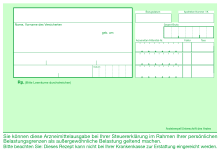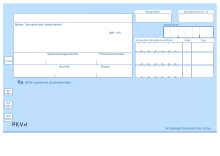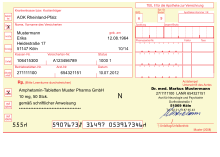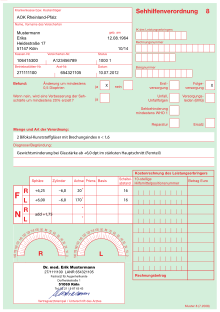Prescription (medicine)
A prescription (from the Latin recipere , to take, see also the origin of the term ), also prescription or prescription , is the written prescription of drugs or remedies in medicine and pharmacy .
A distinction is made between prescription- only (prescription-only) and non- prescription ( non-prescription ) drugs. Only the latter may be given to non-doctors or doctors who are not known or recognized in the pharmacy without presenting a prescription. In many countries, a doctor's prescription is necessary so that the patient can be reimbursed for the purchase price of the medication by the cost bearers / health insurance companies.
Forms and cost units
In Germany the insured of are public health insurance reimbursable medicines or treatments to cash recipes prescribed. The pharmacy or treatment facility settles the costs with the health insurance companies via billing centers (see also prescription billing ). As a rule, the patient must pay a legally stipulated share ( deductible ). Special forms must be used for billing with the health insurance companies (in Germany, for example, the pink pattern 16 for medication prescriptions; patterns 8, 8a, 13, 14 or 18 for medication prescriptions).
Anyone who is not insured through statutory health insurance will receive the prescription on a private prescription (PRV). In this case, the patient has to pay the costs for the drugs in the pharmacy or the remedies or medical treatments himself. Statutory health insurance patients also receive a private prescription if the prescription is not a statutory health insurance benefit. The private prescription does not require any special form. In some cases, green or blue forms are used, the structure of which is similar to pattern 16 of the GKV prescription.
For certain drugs, official forms must be used regardless of the cost bearer and reimbursement eligibility. They are prescribed for narcotics ( BTM prescription ) and for certain teratogenic drugs ( T prescription ).
Drug prescription
A prescription is the formal, written request from a doctor, dentist, veterinarian or alternative practitioner to the pharmacy for a delivery of medicines or aids . Naturopaths are not authorized to prescribe prescription drugs. The pharmacy is obliged to contract and must deliver the prescription in a reasonable time. However, if there are pharmaceutical concerns, ambiguities, indications of errors, or if there is a suspicion of drug abuse or prescription falsification, the order may not be supplied until the ambiguities have been resolved. Prescriptions in the sense of the medication ordinance are documents . Thus, unauthorized changes can be punished as forgery .

While nowadays mostly finished medicinal products are prescribed, in the past it was almost always individually prepared medicinal products ( recipes ). Then the recipe also contained the manufacturing and dispensing instructions. The text still begins today with Rp. (The Latin abbreviation for recipe “take”; according to another or further explanation originated from the symbol for god Jupiter “♃”, in whose name Roman doctors prescribed, or the symbol of the Egyptian eye of Horus reproduced) followed by detailed instructions; for example: “Take 3 grams of this, 40 grams of that, mix, divide into ten servings, give it to the patient and instruct him on the dosage.” The whole text was traditionally written in Latin , the traditional lingua franca of scholars.
Information on the prescription
Paragraph 2 of the Medicinal Prescription Ordinance (AMVV) regulates in Germany which information a prescription must contain:
- First name, last name, job title, address and telephone number of the prescribing person
- Date of issue
- Name and date of birth of the person for whom the medicine is intended
- Name of the finished medicinal product or, in the case of medicinal products to be manufactured in the pharmacy ( formulations ), their composition according to type and quantity as well as instructions for use
- Dosage form and quantity to be dispensed or standard pack size ( if this information is missing, the smallest pack is considered to be prescribed)
- Validity of the prescription (if this information is missing, which is almost always the case; then the validity [as a private prescription] is three months)
- the handwritten signature of the prescribing person or (in the case of electronic prescriptions ) a qualified electronic signature according to the Signature Act
If the prescription is to be paid for by the health insurance company as a prescription, further requirements according to the drug delivery contracts apply.
For veterinary prescriptions, the following must also be stated:
- Name of the animal owner (instead of the person for whom the medicine is intended) and the type and number of animals to be treated
- the dosage per animal and day
- the duration of the application
- for animals for the production of food: identity of the animals, indication and the waiting time .
Similar regulations apply to prescriptions for medical practices, hospitals, rescue service facilities, on-board pharmacies for aircraft, veterinary clinics or zoos.
A doctor can issue additional instructions to the pharmacist by using specific formulations or crosses in the relevant fields. These are among others
- "Noctu" (lat. At night ): The patient should be exempted from a night tax (in the pharmacy emergency service); this is the only way that the health insurance company pays the night tax if the prescription is redeemed within 24 hours in an emergency pharmacy
- " Aut idem " (lat. "Or the same"): The pharmacist may (or must, in the case of discount agreements, in accordance with the health insurance company) dispense another drug with the same active ingredient instead of the one prescribed by name. Originally, the exchange was allowed if the box was checked. However, since this was hardly used by doctors, but the exchange was politically wanted, a change in meaning was ordered from 2002; since then - unlike all the other boxes - the aut-idem rule has to be applied if the box was not ticked; This is to make it clear that the exchange should be the "normal case", which can only be excluded in justified individual cases by actively setting the tick.
- The more far-reaching, but hitherto hardly common note “Aut-Simile” would allow the pharmacist to hand over a similar-acting drug with a different active ingredient. (useful in night shift, if the prescribing doctor is not available)
- "sine confectione" or sc (lat. without packaging ) is practically no longer used: the pharmacist should then dispense a finished medicinal product in neutral packaging and without any instructions for use. This should leave the patient unclear about the type of medicinal product, which - apart from clinical studies, to which the patient would have to give separate consent - would be inadmissible; at least the labeling as prescription drugs according to § 14 pharmacy operating regulations is required.
- "ad manum medici", abbreviated to "ad mm" (Latin: "to the hands of the doctor"): The medicine should not be given to the patient, but to the doctor (who wants to administer it to the patient himself).
- "ad usum proprium" (Latin for "personal use"): the medicine is intended for the doctor himself; So patient and prescriber are the same person.
- "pc" (abbreviation for "pro communitate" - for the general public): The drug is not intended for a specific patient, but rather as a need for consultation
Official prescription forms
Special features are the official prescription forms that are required for prescribing certain drugs.
Narcotic prescription
A narcotics prescription (BtM prescription) is an official form with a yellow cover sheet and is required to prescribe narcotics . For this, the provisions of the Narcotics Prescription Ordinance (BtMVV) must be observed. The prescriptions, which are only valid for seven days after the date of issue (i.e. eight days), are provided with a serial number and are issued in triplicate. One copy stays with the doctor, while the patient returns the other two copies to the pharmacy. One is archived by the pharmacy for three years, while the other is used for billing the insurance provider.
T prescription
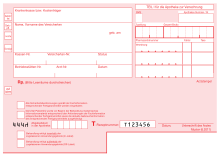
Certain drugs with a high degree of teratogenic effects must be prescribed on a special official form, the so-called T-prescription. Medicines with the active ingredients thalidomide - or lenalidomide (since February 2009) or pomalidomide (since March 2013) are affected . The prescription form is in two parts (original and copy) and is given by the Federal Institute for Drugs and Medical Devices (BfArM) exclusively to doctors with sufficient specialist knowledge, who also ensure that all prescribed safety measures are observed. It is valid for a maximum of six days after being issued by the doctor (i.e. seven days). The doctor must state on the prescription whether the prescription is made within the approved areas of application or outside, as so-called off-label use . The form bears a consecutive T-prescription number and pharmacies must send the copies to the T-Register at the BfArM on a weekly basis. Other drugs may not be prescribed on the T-prescription.
Period of validity and eligibility for reimbursement
In Germany, a prescription is generally valid for three months, a narcotic prescription for eight days, T-prescriptions and prescriptions for certain oral retinoids for seven days (including the day of issue).
A distinction must also be made between the period of validity (in the sense of the prescription regulation) and the reimbursement by the insurance provider. For example, a health insurance prescription can only be redeemed within one month of being issued at the expense of the health insurance company (despite its three-month validity ) . After that, it is still valid as a (private) prescription, but can no longer be billed to the health insurance company. If the pharmacist overlooks this, the health insurance company will retrospectively "retax" the full drug price, ie charge it back. The duration of billing is also different for the individual insurance providers (one month for normal health insurance prescriptions, but in some cases only four weeks for medical aids ordinances; professional associations and other insurance providers, sometimes longer periods). The patient should therefore redeem his prescription within four weeks after it has been issued, even if he does not need the medicine until later. According to the German Medicines Directive, certain medical devices are also reimbursable by the statutory health insurance companies if they are prescribed by a doctor.
Since October 2017 there has been a discharge prescription in which hospital doctors can prescribe medication or aids. Discharge prescriptions may only be supplied by pharmacies within three working days at the expense of the GKV, whereby the day of issue already counts. The pink pattern 16 is used, which is provided with the words "Discharge Management".
Since March 1, 2020, doctors have also been able to issue repeat prescriptions. It enables four deliveries within a year and should save walking distances for patients and time for doctors. Since the billing procedure has not yet been clarified, the German Pharmacists' Association (DAV) is of the opinion that doctors should not issue any repeat prescriptions and advises pharmacies against delivering until this has been clarified.
Wait and See Prescription
The Wait and See Prescription , which occurs in America, is a prescription that is issued by the doctor, but is only redeemed by the patient if certain circumstances arise. The doctor will give you precise instructions for doing this. The advantages are that there is no need to visit the doctor again and drug costs can be saved.
Medicines Ordinance
The doctor, dentist or veterinarian can prescribe not only medicines, but also certain treatment measures ( remedies ). In the German health system, a doctor's prescription is the official name for a remedy prescription for measures for outpatient rehabilitation or for home nursing .
In Germany, this regulation is based on Section 32 of Book V of the Social Code . Further details are regulated in the therapeutic products guidelines . According to the form agreement of the federal shell contracts, there are different forms for the various therapeutic products : Patterns 8 and 8a are used for prescribing visual aids , pattern 13 of the therapeutic products ordinance for physical and podiatry therapy, pattern 14 for voice, speech and speech therapy (colloquially called speech therapy , although non-speech therapists also provide the services), sample 18 for occupational therapy . The doctor, service provider and patient must make entries on the forms: The doctor specifies the patient data, the diagnosis and the therapeutic measure (with the number of therapy units and the frequency) and the latest start of treatment, as well as the date on which the prescription was issued (" Prescription date "). With his signature and his practice stamp, the regulation becomes valid. The therapist enters his / her IC , the number of therapy units performed, the appropriate remedy item numbers as well as the amounts to be paid and the patient's co-payment . The therapist's signature and practice stamp complete his / her entries. Finally, the patient confirms receipt of the services with his or her signature (one signature for each treatment day). The signature of patients who do not know how to write or who are unable to write can be replaced by the signatures of close relatives, accompanying persons or nursing staff. These ordinances are to be settled with the insurance provider without approval. Therapy may only be started if a doctor's prescription is presented. The service provider can directly bill the respective cost unit in the form of a monthly collective invoice. Another possibility is to use appropriate service providers (data centers). According to Section 302 of the Book V of the Social Code (SGB V), therapeutic products must be submitted electronically in Germany . Most cost units use so-called data collection points or invoice verification points to accept, check and pay the incoming invoices .
Origin of the term
In the past, a doctor started the prescription (from Latin receptum ; earlier synonymous with formula ) with the Latin instruction recipe (imperative from recipere , so take ) to the pharmacist in order to inform him which components he needed for the (at that time still from the pharmacist to be mixed) should take drugs (comparable to a cooking recipe; see recipe ). The word recipe [ ˈɾɛsəpɪ ] used today for (cooking) recipe in English is derived from this term . When the pharmacist had given the customer all the ingredients for the finished medicine that was in accordance with the doctor's wishes, he confirmed this on the prescription with the word receptum (Latin participle perfect passive from recipere , i.e. taken ). The German word recipe is derived from this.
Even today, medical prescriptions begin with the (pre-printed) abbreviation "Rp." for Latin recipe , translated to take .
More precisely, one speaks of prescription (formerly Latin praescriptio , English to this day "prescription), since a prescription nowadays has to contain various legally prescribed information in addition to the medication, which are checked by the pharmacist. The official designation in the Social Code is" drug regulation sheet ".
Another word is ordination (from Latin ordinatio 'arrangement'), this can also mean consultation hours or, in Upper German, medical practice .
literature
- Liselotte Buchheim: History of the recipe introduction. Eye of Horus - Sign of Jupiter - Recipe. Medical habilitation thesis, Bonn 1965, published Bonn 1969.
- Liselotte Buchheim: History of the recipe introduction. Eye of Horus - Sign of Jupiter - Recipe. In: Sudhoff's archive. Volume 51, Issue 4, (December) 1967, pp. 318-325.
- Peter Dilg: recipe, recipe literature. In: Werner E. Gerabek , Bernhard D. Haage, Gundolf Keil , Wolfgang Wegner (eds.): Enzyklopädie Medizingeschichte. De Gruyter, Berlin / New York 2005, ISBN 3-11-015714-4 , p. 1246 f.
- Ulrich Seidel: Prescription and pharmacy. On the history of the drug prescription from the 13th to the 16th century. Mathematical and scientific dissertation, Marburg an der Lahn 1977.
- Joachim Telle : The recipe as a literary form: building blocks for its cultural history. In: Medical monthly 28, 1974, pp. 389-395.
Web links
Individual evidence
- ↑ Peter Dilg: recipe, recipe literature. 2005, p. 1246.
- ↑ L. Buchheim: History of the recipe introduction. Eye of Horus - Sign of Jupiter - Recipe.
- ^ National Association of Statutory Health Insurance Physicians : Aut-idem regulation .
- ↑ Federal Institute for Drugs and Medical Devices (BfArM): T-prescription model , accessed on August 7, 2017.
- ↑ a b c § 3a of the Medicinal Prescription Ordinance (AMVV)
- ↑ Appendix V to the Drugs Directive: Overview of medical devices that can be prescribed , accessed on August 7, 2017.
- ↑ Julia Borsch: What pharmacists need to know about the discharge prescription . In: DAZ.online . September 29, 2017 ( deutsche-apotheker-zeitung.de [accessed September 30, 2017]).
- ↑ New provisions for repeat prescriptions and flu vaccinations in pharmacies , ABDA - Federal Association of German Pharmacists' Associations (ABDA), February 28, 2020.
- ↑ Repeat prescriptions currently not billable , ABDA , March 3, 2020.
- ↑ aerzteblatt.de: Otitis media: Contingent prescriptions avoid antibiotic over-therapy. ( Memento of September 9, 2013 in the Internet Archive ) of September 13, 2006 (accessed on May 30, 2013).
- ↑ Therapeutic Products Guidelines (PDF; 549 kB).
- ^ National Association of Statutory Health Insurance Physicians : Federal Shell Contracts ( Memento of December 5, 2010 in the Internet Archive ).
- ^ Johann Philipp Eysel: Enchiridion de formulis medicis praescribendis. Erfurt 1698.
- ↑ Peter Dilg: recipe, recipe literature. 2005, p. 1246.
- ↑ Lingo4you online dictionary (accessed May 30, 2013).
- ↑ TheFreeDictionary online dictionary: prescribe (accessed May 30, 2013).
- ↑ duden.de: Ordination (accessed May 30, 2013).


